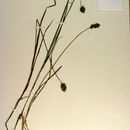Comprehensive Description
provided by North American Flora
Carex scoparia Schkuhr; Wilid. Sp. PI. 4: 230. 1805
"Carex leporina L." Michx. Fl. Bor. Am. 2: 170. 1803.
Loncoperis scoparia Raf. Good Book 27. 1840. (Based on Carex scoparia Schkuhr.)
Carex scoparia var. vera Tuckerm. Enum. Caric. 17. 1843. (No types given.)
Carex scoparia var. moniliformis Tuckerm. Enum. Caric. 17. 1843. (No types given.)
Carex scoparia var. aggregata Dewey, in Wood. Class-Book ed. 2. 580. 1847. (Type from the eastern
United States.) Carex lagopodioides var. scoparia Bock. Linnaea 39: 114. 1875. (Based on C. scoparia Schkuhr.) Carex tribuloides var. reducta L. H. Bailey, Proc. Am. Acad. 22: 148, in small part; not as to type.
1886. Carex tribuloides var. moniliformis Britton; Britt. & Brown, 111. Fl. 1: 356. 1896. (Technically
based on C. scoparia var. moniliformis Tuckerm.) Carex scoparia var. condensa Fernald, Proc. Am. Acad. 37: 468. pi. 1, f. 5. 1902. (Type from
New Hampshire.) Carex scoparia I. moniliformis "Tuckerm." Kiikenth. in Engler, Pflanzenreich 4 M : 203. 1909.
(Based on C. scoparia var. moniliformis Tuckerm.) Carex scoparia f. tenerrima Kiikenth. in Engler, Pflanzenreich 4 20 : 202. 1909. (Type from Vermont.) Carex scoparia f. condensa "Fernald" Kukenth. in Engler, Pflanzenreich 4 20 : 203. 1909. (Based
on C. scoparia var. condensa Fernald.) Carex scoparia var. tesscllata Fernald & Wieg. Rhodora 12: 135. 1910. (Type from Washington
County, Maine.) Carex scoparia var. sublurbinata Fernald & Wieg. Rhodora 14: 116. 1912. (Type from Rushy
Pond, Newfoundland.) Carex scoparia f. peracuta Fernald, Rhodora 23: 234. 1922. (Type from Yarmouth County,
Maine.) Carex scoparia var. intermedia Olney; Dudley, Bull. Cornell Univ. 2: 1!2. 1886. (Type from
Cayuga Lake Basin.)
Densely cespitose, the rootstocks short, dark-brown, fibrillose, the culms 1.5-10 dm. high, usually strongly exceeding the leaves, slender to base, not strict, sharply triangular, strongly roughened on the angles beneath the head, brownish at base and clothed with the dried-up leaves of the previous year, the lower sheaths bladeless; leaves with well-developed blades 2-6 (usually 3-5) to a fertile culm, on the lower half, but usually not clustered, the blades 0.5-5 dm. long, 1.5-3 mm. wide, flat or canaliculate, yellowish-green, very rough towards the apex, the sheaths tight, white-hyaline ventrally, short-prolonged beyond base of blade and continuous with ligule; sterile shoots elongate, with few leaves clustered at apex, the blades erect; inflorescence 1-5 cm. long, 5-15 mm. thick, consisting of 3-12 very clearly defined spikes aggregated into an oblong or linear-oblong or globose head, or the inflorescence moniliform, flexuous, the spikes gynaecandrous, short-oblong or ovoid-oblong or subglobose, ascending or erect, straw-colored, 6-16 mm. long, 3-9 mm. wide, tapering to a blunt point or rounded at apex, round or tapering at base, the basal staminate flowers very inconspicuous, the numerous perigynia appressed or erect-ascending, with appressed-erect beaks; one or two of the lower spikes with small inconspicuous setaceous bracts shorter than the head; upper bracts not developed; scales ovate or oblong-ovate, dull, light-brownish with narrow whitehyaline margins and 3-nerved green center, acute, nearly the width of perigynia below but noticeably exceeded by their tips; perigynia flat, barely distended over the achene, 4-6.5 mm. long, 1.2-2 mm. wide, lanceolate to narrowly ovate-lanceolate, membranaceous, greenish-white with green margin above, or straw-colored at maturity, noticeably (but not broadly) wing-margined to the base, serrulate to below middle, strongly to lightly manynerved dorsally and several-nerved ventrally, round-tapering at base, tapering into a beak about one third the length of the whole, flat, serrulate, obliquely cut dorsally, reddish-browntipped, shallowly bidentate, the margins of the orifice narrowly reddish-brown; achenes lenticular, oval-oblong, 1-1.5 mm. long, 0.5-0.75 mm. wide, short-stipitate, apiculate, brownish; style slender, straight, jointed with achene, at length deciduous; stigmas two, short, reddish-brown.
Type locality: "Habitat in America boreali."
Distribution: Open swampy or wet places, Newfoundland to British Columbia, and southward to South Carolina, Arkansas. New Mexico, and Oregon. A very widely distributed species, often abundant in swampy meadows. (Specimens examined from Newfoundland, Prince Edward Island, Nova Scotia, New Brunswick. Quebec, Ontario, Maine, New Hampshire, Vermont, Massachusetts, Rhode Island, Connecticut, New York. New Jersey, Pennsylvania, Delaware, Maryland, District of Columbia, West Virginia, Virginia, North Carolina, South Carolina, Tennessee. Ohio, Indiana, Illinois. Michigan, Wisconsin, Minnesota, Iowa, Missouri. Arkansas, Nebraska, South Dakota, Colorado, Saskatchewan, New Mexico, Idaho, Oregon, Washington, British Columbia (Vancouver Island, introduced).)
- bibliographic citation
- Kenneth Kent Mackenzie. 1931. (POALES); CYPERACEAE; CARICEAE. North American flora. vol 18(3). New York Botanical Garden, New York, NY

